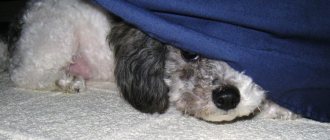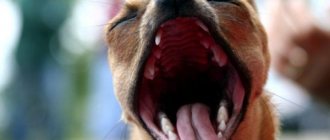Animals do not behave like humans when they are in pain. It is worth remembering that they have a fairly high pain threshold, that they will hide their suffering until the last moment (it is nature’s nature not to show weakness) and that they will not point a clawed finger at a ripening abscess.
Often, owners do not understand why, during illness, their pet behaves differently than usual, for example, it becomes withdrawn and unsociable, may bite, or goes away and hides. Just as often, owners attribute changes in behavior to something, such as the weather or a “bad mood,” when the animal is simply in pain.
There are, of course, manifestations of pain that cannot be confused with anything, for example, lameness. But otherwise, it’s unlikely that your dog will come up and say: “Master! My back hurts around the kidneys! I need to see a doctor!”, no, she will sit tense with a hunched back and suffer in silence.
Pain is one of the most obvious symptoms, so owners usually notice it first. Pain is a reason to contact your veterinarian immediately. External manifestations often depend on the intensity and location of the pain, but after living a little with a dog and getting to know the pet better, everyone sooner or later begins to understand its body language.
Symptoms of pain. Let's look together at which of them are most common:
1) The dog barks, whines, howls, growls.
May do this in conjunction with some action (for example, growling at a sore paw) or simply lie/sit/stand, stare into space and whine. This also includes whining and squealing when trying to be picked up. Many dogs even in their normal state vocally accompany their behavior, for example, barking when they are happy or whining when begging. This is fine. BUT if your pet makes sounds more than usual or accompanies them with atypical behavior, this is a reason to be wary. I have a patient who barks when he has colic and stomach pain. He's already a loud enough dog, but if it hurts... he doesn't shut up.
2) Excessive grooming.
Dogs try to clean their wounds, so cuts, abscesses, broken claws, and abscesses are actively licked. If a dog frequently or continuously licks a certain place, then you need to look for a problem there. This also includes several other situations: - if the eyes hurt or itch, the dog rubs them with his paw or rubs them against various objects in the house. — some dogs bite the place where it hurts. The more it hurts, the more intense it is. - if teeth hurt or problems in the mouth or throat - the dog puts its paws into its mouth, tries to gnaw hard objects, scratch, rubs its muzzle on hard surfaces. - if there are problems in the genitals (especially in males), this area is also subject to active grooming.
3) Sleep disturbance.
The dog begins to sleep a lot or, on the contrary, cannot sleep for a long time and constantly wakes up. It will be the first or the second, depending on the nature of the pain.
4) Violation of food and water intake.
If a dog has pain in the mouth, throat, or stomach, it may refuse to eat food, and sometimes even water. Also, refusing to eat can mean nausea and excessive pain in other areas. In some inflammatory processes, the amount of water consumed increases.
5) Shortness of breath, heavy and/or shallow breathing
. The most obvious sign of severe pain. Sometimes, the only one.
6) Forced posture and restlessness.
If the dog constantly changes position, lies down and immediately gets up, walks, looks for a place, lies down and gets up again, then something is bothering him. It happens that when there is pain in certain areas, dogs take a forced position: for example, a hunched back is a sign of pain in the abdominal cavity. Walking in circles and chaotic movements can also be a sign of anxiety. The dog may have difficulty or be reluctant to lie down or get up, or refuse to jump on the sofa.
7) Unmotivated aggression.
Often, a dog may show dissatisfaction if you touch a sore spot, sometimes going so far as to growl and bite if the owner puts too much pressure on a sore paw or stomach. Before looking for a psychological aspect in a dog’s aggression, we need to understand whether the dog is telling us that we don’t need to touch it in this place. Aggression can also be a sign of constant irritation against a background of pain; pain sometimes causes inappropriate behavior in both people and animals.
 Sociability.
Sociability.
Every dog reacts differently to feeling unwell. One will hide away so as not to be touched, and the other, on the contrary, will constantly stay close and put the place that hurts under the arm so that it can be stroked (this does not apply to all types and places of pain). An attentive owner who has known his pet for a long time will immediately notice that the dog’s behavior has changed.
9) Lameness, abduction or curling of the paw.
Lameness is the most visible symptom of pain. Just remember that if an animal limps or stretches its paw, this does not always mean problems with the limbs; sometimes lameness is a sign of pain in some abdominal organs or pain in the spine. This also includes the so-called “wooden gait”, any changes in gait.
10) Unusual urination and bowel movements.
An attempt to move during urination and defecation, to find a different position, an atypical position, frequent urges, vocal accompaniment - all this indicates that there is a problem.
11) Other possible symptoms of pain in dogs:
- Frequently or closely looking at the disturbing part of the body. Sometimes surprised, sometimes aggressive. - Tilt the head to one side. It may be a sign of neurological problems, as well as pain in the ears, any part of the head, otitis media. - Cramps. Especially in brachycephalic breeds. For example, seizures in a French bulldog is a reason to find an orthopedist and examine the dog for a sphenoid vertebra.
PS While I was writing this article, I remembered how my dog “didn’t like” beef lungs. This is someone who can reveal all their pain in a theatrical mini-production! At first he looked back at his stomach, often, and when it was seething, also with great surprise. Then he climbed onto the sofa (which he absolutely cannot do), placed his entire heavy body in my arms, hunched over and froze. Here it is, the picture: “Colic, pain and spasms in the intestinal area”!
Be attentive to your dogs, do not miss the symptoms of pain in their behavior! Every caring owner should try to provide the necessary veterinary care to their beloved pet in a timely manner!
The article used materials from this site.
Why does an adult dog whine?
Whining is common in adult dogs. This behavior may be associated with health problems, characteristics of upbringing and behavior, and living conditions. If your pet constantly whines even without obvious reasons, you should contact a dog trainer or veterinarian. Below are the main reasons why a dog cries and cannot find a place for himself.
Health problems
If you notice that the animal is trembling and whining pitifully, this may be due to physiological problems. Possible causes and typical manifestations:
- Diseases of the musculoskeletal system. This may be the destruction of joints due to age or pain after an injury. The dog may whine, limp and move poorly. Most often, the dog takes a comfortable position and finds it difficult to get up and walk. In this case, it is recommended to carry the pet only in a horizontal position.
- Pathologies in the oral cavity. Sharp objects and pieces of food often get stuck in the mouth. If you notice that the animal is breathing frequently or making unusual sounds, you should check the condition of the gums and teeth.
- Ear diseases. Ear mites and common otitis media are more common, causing the dog to scratch its ears and whine. A veterinarian examination is required.
- Indigestion. Characteristic features are refusal to feed, changes in behavior after eating, vomiting and diarrhea. It is recommended to undergo a full diagnostic to accurately determine the cause of this problem.
- Infestation with parasites. If you notice that your dog whines when he poops or rides on his butt after defecation, he may be infected with worms. For treatment and prevention, special anthelmintic drugs are prescribed.
A dog that whines can signal its health to its owner. If this is accompanied by a violation of the usual lifestyle, refusal of water and food, you need to show your pet to a qualified veterinarian.
Behavior problems
The most common reason why a dog whines is its reaction to living conditions, as well as mental characteristics. Whining is most common in restless and anxious pets when the owner leaves. The main factors triggering atypical behavior:
- the bitch's reaction to being weaned from her puppies, which can last up to several weeks. In this case, the dog hardly sleeps at night, walks around the house and makes various sounds;
- loud noises outside the house - thunderstorms, firecrackers, car alarms and gunshots. The dog runs around the apartment, behaves restlessly and hides in the darkness;
- boredom for the owner when the dog is left alone. A similar reaction can occur when kept in an apartment or in an enclosure;
- whining in dogs is also observed after punishment by their owner for any offense or fault. Usually the dog stops whining after reconciliation if the owner offers a treat.
In addition, the dog may whine after any surgical intervention, for example, after sterilization. In this way, the animal demonstrates discomfort and pain. Often, bitches whine after estrus, which is caused by changes in hormonal levels; normally, this behavior goes away within 1-2 days.
Behavior driven by instincts
Dogs are hunters by nature, and this quality manifests itself to varying degrees in different breeds. If you notice that the dog is thrashing around and whining, then perhaps he has noticed the prey, but cannot catch it. This problem is often observed in dogs that spend a lot of time on the balcony or in an enclosure. Overexcitation from the sight of birds, cats and other animals running nearby can persist even after castration in male dogs.
Psycho-emotional factors
A common reason why a dog whines. In this way, animals express their emotions, reactions to the owner and external factors. It could be joy, excitement, fear or worry. Whining can be triggered by various reasons:
- the appearance of a child or a new animal in the house;
- boredom of the owner when they are left alone all day;
- reaction to returning after a walk;
- dreams (when a dog whines in his sleep).
If the dog is shaking with excitement and cannot calm down for a long time, you need to offer it a treat, pat it a little at the withers or stroke it behind the ears. Some dogs begin to be cunning - they whine to beg for food or a walk. For example, a dog sits on its hind legs and looks straight into the eyes, making various sounds. This behavior should be stopped by expressing dissatisfaction and reprimanding your pet.
What to do if your dog whines at night
As a rule, adult dogs sleep at night if their day has been eventful and active, the pet is well-fed and healthy. Therefore, most often small puppies make cutting, unpleasant sounds at night, and this is most often explained not only by a sharp change in their usual environment, but also by fear and loneliness.
During the first few days, whining is quite normal. He is frightened by new surroundings, smells, sounds. Some dog breeders recommend taking your pet to the bed. But dog experts do not recommend doing this. The puppy will get used to sleeping with you and it will be difficult to accustom an older pet to a place.
To stop your puppy from whining:
Organize a comfortable bed or house for the new member of your family.
If possible, do not leave the dog alone for a long time, and especially do not lock the puppy in a crate or in another room.
Protect your dog from stress and negative emotions. The period of adaptation and socialization should be as calm and favorable as possible.
If the puppy is a little over a month old, at this age it is not advisable to separate him from his mother. But if this happens, place the dog bed near your bed and as soon as the baby whines, calm him down and pet him. Once the puppy calms down, praise him.
Gradually move the lounger further away from the bed and react less to whining. Pay more attention to your pet so that he quickly gets used to his new home and can more easily endure separation from his mother. To help the puppy better tolerate separation from his mother-dog, ask the breeders for toys, a cloth, things that have retained familiar smells. Place them near the bed or in the house where your small pet sleeps, and he will behave more confidently and calmly. You can also use a heating pad or a bottle filled with warm water. Wrap it in soft cloth and place it near the puppy.
If the puppy, having adapted to new conditions, continues to howl and whine at night, leave the light or night lamp on. Approach the dog and calm it down in a gentle tone. If the whining does not stop, perhaps the puppy does not want to sleep and is bored. Place toys and tooth sharpeners near the baby. After playing enough, the dog will get tired and sleep peacefully.
Gradually accustom the dog to the command "", "Fu", "" or any other prohibition commands. Give the command in a strict tone, and as soon as the dog has shown obedience, reward it with a gentle intonation or a treat. To prevent the puppy from getting bored when you are not at home, leave him various toys. Otherwise, the dog will not only howl, but will also begin to damage furniture and wallpaper.
Physical activity is equally important. After quarantine, walk your dog several times a day, gradually increasing the walking time. Accustom your puppy to communicate with his relatives, so that he then reacts normally to other dogs and animals.
Why does a puppy whine?
Puppies weaned from their mother take a long time to adapt to the conditions in their new home. The period of addiction is enhanced by active physiological changes in the body. This is why a puppy may make whining sounds during the day, but almost always stops whining at night. Main reasons:
- weaning from the bitch and her litter, getting used to new smells;
- discomfort after vaccination;
- fear when the dog is left alone;
- various diseases, helminthiasis;
- lack of attention of the owner;
- anxiety when changing your lifestyle, being transported in a car, or after meeting new people.
If you notice that your pet is shaking and crying, you should calm the puppy down as quickly as possible. To do this, take it under your front paws, hold it close to you and stroke it in the direction of hair growth, behind the ears. If the animal is under 2 months old, offer a pacifier with milk or a special formula. Puppies should absolutely not be scolded, as this can cause serious changes in the psyche, severe human fear and chronic somatic diseases.
What to do if your dog whines at night
As a rule, adult dogs sleep at night if their day has been eventful and active, the pet is well-fed and healthy. Therefore, most often small puppies make cutting, unpleasant sounds at night, and this is most often explained not only by a sharp change in their usual environment, but also by fear and loneliness.
During the first few days, whining is quite normal. He is frightened by new surroundings, smells, sounds. Some dog breeders recommend taking your pet to the bed. But dog experts do not recommend doing this. The puppy will get used to sleeping with you and it will be difficult to accustom an older pet to a place.
To stop your puppy from whining:
Organize a comfortable bed or house for the new member of your family.
If possible, do not leave the dog alone for a long time, and especially do not lock the puppy in a crate or in another room.
Protect your dog from stress and negative emotions. The period of adaptation and socialization should be as calm and favorable as possible.
If the puppy is a little over a month old, at this age it is not advisable to separate him from his mother. But if this happens, place the dog bed near your bed and as soon as the baby whines, calm him down and pet him. Once the puppy calms down, praise him.
Gradually move the lounger further away from the bed and react less to whining. Pay more attention to the pet so that it quickly gets used to its new home and can more easily endure separation from its mother. To help the puppy better tolerate separation from its mother-dog, ask the breeders for toys, a cloth, and things that retain familiar smells. Place them near the bed or in the house where your small pet sleeps, and he will behave more confidently and calmly. You can also use a heating pad or a bottle filled with warm water. Wrap it in soft cloth and place it near the puppy.
If the puppy, having adapted to new conditions, continues to howl and whine at night, leave the light or night lamp on. Approach the dog and calm it down in a gentle tone. If the whining does not stop, perhaps the puppy does not want to sleep and is bored. Place toys and tooth sharpeners near the baby. After playing enough, the dog will get tired and sleep peacefully.
Gradually accustom your dog to the command “Place”, “Fu”, “No” or any other prohibition commands. Give the command in a strict tone, and as soon as the dog has shown obedience, reward it with a gentle intonation or a treat. To prevent the puppy from getting bored when you are not at home, leave him various toys. Otherwise, the dog will not only howl, but will also begin to damage furniture and wallpaper.
Physical activity is equally important. After quarantine, walk your dog several times a day, gradually increasing the walking time. Accustom your puppy to communicate with his relatives, so that he then reacts normally to other dogs and animals.
How to stop your pet from whining
First of all, you should understand the reasons why the dog is whining, and only then take active action. In most cases, it is enough for the animal to satisfy its physiological needs - for this it needs to be fed, walked, if it asks to go outside. Sociable dogs require attention, especially if you have not been around for a long time. Steps to quickly calm your pet:
- consciously ignore if your pet tries to get your attention by whining;
- offer a favorite toy, bone or treat;
- distract by executing practiced commands;
- caress and scratch, pick up.
From a young age, you should not allow your pet to violently express its emotions. If he starts barking or whining when overexcited, he needs to be calmed down immediately and his energy transferred to active behavior and communication.
If firecrackers and fireworks are planned, it is recommended that the dog be kept in a confined and dark area where he can be safe (for example, in the bathroom or bedroom). Drinking water and food must be left there.
Puppies should be taught to be alone almost as soon as they arrive in the house. Gradually increase your weaning time from 2 minutes to several hours. Immediately after returning, praise for waiting and give a treat. It is useful to install a camera in the apartment so that you can monitor the dog while you are away. This is especially beneficial for active breeds such as huskies, large terriers, boxers and pit bulls.
Causes
A dog may hide under the bed for several reasons.
- Fear. Seeking cover can be evidence that your pet is scared. For example, some dogs hide under the bed during thunderstorms, firecrackers, or other loud noises.
- Diseases. One of the reasons that a dog hides under the bed is that the pet has viral or infectious diseases - at this time, pets often prefer to be alone, choosing a closed and dark space.
- Loneliness. If the dog is under the bed, this may be a sign of boredom or sadness for the owner.
Briefly about the main thing
- A dog can whine due to health problems, against the background of psycho-emotional factors, and as a way of communication.
- Bitches after estrus and during false pregnancy can whine with a toy; whining is also observed when overexcited.
- Dogs dream, so they may whine and move their paws while they sleep. This reaction is more common in puppies.
- In order for your pet to stop whining, you need to understand the reasons for this behavior. If necessary, contact a veterinarian.
Does your dog whine towards the apartment? Write in the comments how you deal with this behavior.
Should I worry if my dog is acting restless? First, you need to understand that there are psychological reasons for restless behavior in dogs. Diagnosis of psychological abnormalities is complex and is carried out only if the pet is healthy.
Resource protection
Dogs, when they find a treat in the form of a bone, can hide so that nothing distracts them from the long-awaited pleasure. In addition, they believe that the “delicious food” they find can be easily taken away. Still, you shouldn’t ignore this point, but it’s better to keep track of what exactly your pet is gnawing on. An interesting object may be new shoes or small valuables. The latter, if careless, can get stuck in the animal’s throat.
We also recommend reading:
The largest dog breeds What is domestication in animal husbandry Why you should get a cat: reasons voiced by scientists Euthanasia of animals
Psychological causes of restless behavior in dogs
A dog's restless behavior is a signal to be alert and analyze its general condition. It is important to understand that the causes of restless behavior can be physiological and psychological.
For physiological reasons, the dog is anxious due to discomfort. Most often, the “root of the problem” is that the dog cannot sleep properly, suffers from chronic fatigue and lack of self-confidence.
The psychological causes of restless behavior in dogs are very multifaceted and most often complex, so their diagnosis is extremely difficult.
Diagnosis of mental disorders is associated with a number of difficult issues:
- You need to make sure that the dog is completely physically healthy - this is almost impossible.
- It is necessary to carefully track the history and analyze what events preceded changes in behavior.
- It is necessary to carefully analyze the environment, including ecology, climate, quality of the food the dog eats, etc.
The only psychological reason that is commonly used to “denote” restless behavior is stress. Usually, the diagnosis is confirmed or removed after a trial course of sedatives.
What should the owner do?
First of all, it is important to understand the reasons for your pet’s behavior, and only then take measures to correct the behavior. In most cases, it is enough to satisfy physiological or psychological needs. But sometimes pets begin to be cunning and get used to raising their voices without the slightest reason. In this case, it will be useful to apply the following recommendations:
- Never encourage or praise your dog while whining, so that he does not consider such behavior to be the norm.
- Ignore (do not look, do not talk) if there is no reason for whining, so that the pet understands that such behavior will not bring the desired result.
- Play. You can show your dog his favorite toy and turn his attention to it. Moreover, this method will evoke more positive emotions in the animal compared to the previous option.
- Distract. If the dog has mastered the commands, you can ask him to follow some of them so that he switches to a new activity.
Important! It is better to reward your dog for being quiet rather than punish or scold him for unwanted actions.
To prevent your pet from getting used to whining, dog breeders recommend:
- Gradually teach him to stay at home on his own.
- Feed him on time and take him for walks to burn off excess energy. To do this, you can create a schedule that will suit both the animal and the owner.
- Pay attention and play more often.
- Monitor your health and behavioral characteristics.
- Study the animal’s fears and try to limit their impact.
- Take into account the individual characteristics of the breed and the pet itself.
A dog's whining may only seem cute at first glance. If, without understanding its reasons, the owner immediately calms and caresses the pet, this will only worsen the situation. Therefore, it is important to carefully understand the reasons for whining in order to better understand your pet and prevent such behavior in the future.
Why does a dog hide in a dark place, under a bed or sofa, climb into a closet or pantry, hide in a corner and turn away? Quite a few dog owners are faced with this issue after noticing strange behavior in their pet. Where does this secrecy come from and could it indicate serious problems? Let's take a closer look.
While living with a dog, you have probably noticed that after playing, walking, active communication or eating, the pet goes to the same place. This behavior is explained by the desire for peace - this is a natural reflex and there is nothing strange about it. However, if your ward has become too secretive and hides most of the day, you should be wary.
Below we will look at the probable causes of strange behavior and recommendations for eliminating them.
Fear
– this is a very important emotion for survival, protecting the pet from stupid and risky actions. Fear is the most common reason that a person in his care hides in the dark. In addition to the desire to hide, fear is accompanied by a number of signs: trembling, constriction of the pupils (in the light), increased breathing, whining, growling when approaching, etc. One of the clearest signs of fear is this.
What can a dog be afraid of while at home? Strangers
- It’s impossible to say by what specific signs, but dogs can distinguish bad people from good ones. Some breeds, for example guard dogs, tend to attack enemies. Decorative pets and dogs with an undeveloped guarding instinct may become frightened and hide. Fear of people is always a bad sign. Normally, four-legged animals are not afraid of meeting a person, but may avoid contact afterward.
Experience
– the best teacher for dogs too. Many people take adult dogs into their home along with their baggage from the past. The problem is that it is very difficult to establish how and where the dog lived previously. After a period of adaptation, the owner is faced with a number of problems and most of them are completely unreasonable from the point of view of life here and now. In this case, only observing the dog’s behavior will help. Four-legged animals always react in a chain, reflexively, that is, they are afraid of something specific. By identifying the pattern, you can break the connection that leads to fear.
Certain dogs that have experienced abuse or cruelty in the past
, it is impossible to re-educate. Fear accompanies them for the rest of their lives and they need to come to terms with this fact. If no behavior correction methods help, the pet remains timid and fearful, the only alternative is waiting and support. It happens that animals overcome their phobias on their own, knowing that they are loved and cared for.
Adult dogs that have survived violence hide in the first days of life in a new home
.
If you notice this behavior in your puppy, it may also be related to fear. Some people do not see anything wrong with physically punishing dogs for the slightest offenses, but in fact, such behavior traumatizes the psyche. Puppies separated from their mother early also often develop phobias
. Panic can only be eliminated by complete rest, that is, the dog hides to calm down a little.
Important!
Obsessive anxiety or obsessive-compulsive disorder are two dangerous reasons why a dog might hide in the dark.
Anxiety
is a multifaceted emotion that can lead an animal to depression or a nervous breakdown. Stress is not bad if it is short-lived. A simple example: a small child and a dog live in a house. The four-legged dog is gentle with the baby, and the child allows himself to play cruelly. The dog endures as much as it can, but when games cause pain, the pet hides. This continues day after day, the dog is in a constant state and is afraid even of the steps of a child. Further, there are two possible scenarios with the same outcome: the pet will defend itself and bite the child, or it will tolerate it, receive mental trauma, lose control of itself and bite the child.
Note!
The desire to hide in the dark is always associated with fear, which is justified by experience, instincts or physiological reasons.
Restless behavior as a sign of illness
Restless behavior as a sign of disease is the first assumption that is analyzed by the veterinarian. If, against the background of anxiety, the dog looks tired and less active, most likely the reasons really lie in physical discomfort.
However, there are exceptions and controversial points. So-called psychosomatic diseases are mental disorders that cause real physical consequences.
Due to anxiety and/or stress, the dog develops a physical illness. Contrary to popular belief, psychosomatic diseases develop rapidly, so their timely diagnosis is extremely important for full rehabilitation.
"Go into your shell"
It happens when an animal falls under the hot hand of its owner or hears how it is menacingly reprimanded in a raised voice for an offense. A dog is capable of feeling guilty and understanding at what point it upset its owner. In this situation, she adopts the tactic of retreating with a dejected look, waiting for the storm to subside. She is still ashamed to return to her favorite places in the apartment, so she will find additional points for herself where she can wait out the owner’s emotional outburst. He will wait an hour or two, and will boldly come out of hiding.
Additional symptoms and their explanation
If your restless behavior is due to physical illness, you may be able to look for additional symptoms.
The dog is rushing about and cannot find a place for itself
If the dog is rushing about and cannot find a place for itself, the reasons may be:
- Stress.
- Sounds that the dog hears but you don’t and/or other irritating factors.
- Phobias.
- Physical pain.
A sudden change in behavior and the appearance of anxiety may be associated with recent stress or very real irritating factors. If you live in an apartment, your dog may suffer from ultrasonic repellers installed by your neighbors. The pet can hear footsteps in neighboring apartments and smell animals.
Note! If a dog of the opposite sex lives in the same building as you, your pet may become very restless during the heat period.
Phobias require long-term correction and constant participation of the owner. Physical pain occurs against the background of diseases, the diagnosis of which must be carried out by a doctor.
The dog is restless at night
If your dog is acting restless at night, the likely causes are:
- Irritating factors in neighboring homes or on the street.
- Lack of physical activity.
- Sluggish chronic diseases, such as arthritis.
Restless behavior at night is often encountered by owners who work and do not devote enough time to walking their dog. After a short morning walk, you go to work, and your bored pet goes to bed. Thus, the dog is at rest all day, goes for a short walk in the evening and has nowhere to put its energy.
Note! Being active at night is a way to attract the owner's attention.
Answer
The Pinscher is a small dog, inquisitive, hyperactive, and therefore difficult to care for. You should not take your eyes off them; the pinscher may run away or eat small objects. Dogs love family, are attached to their owners and are the center of attention.
Common diseases and prevention:
- Periodontal diseases. Plaque turns into tartar and is the cause of disease. Affects gums and promotes tooth loss. In severe cases, it affects the jaw. Doctors recommend having your mouth examined twice a year.
- Diabetes. The body does not control blood sugar levels. Causes increased water consumption, uncontrolled urination and weight problems. To prevent diabetes, you need to have your urine and blood tested annually to check your blood sugar levels.
- Urolithiasis disease. Residues of salt fall out in the urinary tract, bladder or kidneys, forming stones. Stones irritate the mucous membrane, lead to inflammation of organs, and prevent urine output. To prevent the disease, you need to get tested annually.
If the animal itches
The animal itches and looks restless for the following reasons:
With obvious mental disorders, the dog scratches the skin until it bleeds. Quite often, you can observe your pet licking its front paws. When the dog is excited, he often and nervously licks his muzzle. Such conditions can be treated with long-term therapy, massage, changes in feeding and walking schedules, and increased attention from the owner.
Your dog may be itchy and anxious if he is infested with fleas, ticks, or other parasites. To protect your pet from unwanted “neighbors,” you need to carry out preventive measures once every 1–3 months, depending on the drug chosen.
The dog is nervous before traveling or in the car
Severe anxiety before traveling or in the car is a natural reaction of a dog. It is important to understand what a pet experiences if its trajectory of movement is not under control.
Stimuli and irritants
Quite often, dog owners are faced with the problem of whining when the pet notices any irritant. Most of the trip is calm, but as soon as the pet sees another dog or cat, he begins to whine and howl. Over time, the excitement does not go away, but only increases, which leads to the development of a hysterical state.
Stimulants for excessive arousal may include:
- Other animals.
- Cyclists and motorcyclists.
- Smells.
- Sounds. • Weather conditions – thunderstorm, heavy snowfall, hail.
If a dog is very worried when reacting to stimuli, the owner should think about his level of socialization. As a rule, well-socialized animals calm down within 1–3 minutes, after the stimulus is removed from sight.
Choleric dogs also tend to fall into a state of hysterical excitement. The reason for whining in this case is a feeling of novelty.
Quite often, dogs react sharply to stimuli if they lack physical activity. Simply put, when you see a dog on the street, your pet begins to be jealous and indignant because it has not been walked for a long time.
Factors that provoke restless behavior in dogs
Quite a lot of situations lead to a dog being excited, which can provoke anxiety. Let's look at the factors that provoke restless behavior in dogs.
Anxiety after birth in nursing dogs
Concern after birth in nursing dogs is quite natural, since the young mother is worried about the safety of her offspring. In addition, dogs, like people, have very affectionate feelings towards puppies, so they may become worried when babies squeak and become active.
Anxiety during heat
It's natural to feel anxious during heat, as your dog experiences very real physical discomfort. It is especially difficult for dogs during their first heat, as they feel constant nagging pain in the lower abdomen and a frequent urge to urinate.
Dog worry after surgery
Anxiety after surgery is due to the fact that the dog comes out of anesthesia and feels physical pain. During rehabilitation therapy, the dog is prescribed painkillers, but their dose is calculated so that the pet feels discomfort and spares itself.
Excited state after vaccination
Anxiety after vaccination can be considered a side effect. Despite the loyalty of modern vaccines, which should not cause any side effects or complications, individual reactions are observed quite often.
After vaccination, the dog may experience weakness, suffer from fever, pain at the injection site, and mild nausea. If your pet does not have an acute allergic reaction, there is no need to worry. Side effects resolve without intervention within 24 hours. You can help your dog by providing him with complete peace and comfort.
Nature
According to experts and dog breeders, the reason may be the natural origin of dog breeds from wolves. Wolves dig their lair in the ground, since the dog is a direct descendant of the wolf, it retains the same genetic characteristics. The wolf’s den is protected by earthen walls on all sides, and a dog that has crawled under the bed is protected by a mattress on top, and on the sides by the walls of an apartment or house.
There is no need to fight nature, but take the genetic characteristics of dogs for granted and buy her a house made of padding polyester for dogs, which can easily replace a wolf’s den.
How to calm a dog at home?
In some cases, the owner's direct involvement is required, and sometimes the dog needs to be left alone or isolated.
To calm your dog, try calling your pet, talking to him and tracking his reaction. If the dog calms down, great; if not, use the opposite tactic. Take the dog to a bed and leave it alone, observe the changes. If your pet falls asleep, most likely he is hyperactive because he is suffering from overfatigue.
In case of strong excitement, the dog may show aggression or behave completely inappropriately. The only most gentle method to calm a pet is to isolate it in a separate room and not show emotions in response.
If a dog looks nervous all the time, itches, licks its paws, and does not listen, a comprehensive approach is required to help. At home, you can use standard sedatives (strictly according to the instructions). Another method of help is to increase the duration and activity of walking; the more tired the dog is, the faster it will fall asleep after returning home.
Bad feeling
As their health worsens, dogs prefer to hide in secluded places or lie down in the corner of the room. If you notice a similar condition in an animal, observe it. Determine whether the atmosphere in the house is comfortable; perhaps there have been changes that the pet is trying to get used to. If you notice alarming symptoms such as weakness, lethargy, refusal to eat, take the animal to the veterinarian.
In what cases is a visit to the clinic strictly necessary?
In what cases is a visit to the clinic strictly necessary:
- The dog is in obvious pain.
- The pet developed wounds, scratches, and eczema.
- There are strong changes in appetite.
- The dog refuses water.
- There is a sharp gain or loss of weight.
- The dog is suffering from fever.
- There are signs of allergy or intoxication.
- The dog's mucous membranes turn blue when excited or when it calms down.
It is important to understand that constant anxiety will remain a psychological problem “for the time being.” Stress can cause or exacerbate diseases of absolutely any type. It has been proven that dogs that constantly live in a stressful environment are more prone to contracting viral, infectious and even colds.
Diseases and injuries
The dog's feeling of pain and discomfort
- these are more than good reasons to look for a secluded, dark place. Almost always, in addition to secrecy, the dog notices loss of appetite, apathy, and deterioration in the condition of the coat. In the wild, a sick animal is killed by the teeth of a healthy one, so the dog instinctively hides pain and discomfort.
You should be wary and consult a doctor if you notice:
- Excessive concern or complete indifference of the dog.
- The dog constantly licks the same place.
- Breathing too quickly or too slowly.
- Change in color of mucous membranes.
- Complete refusal to drink.
- A clear expression of pain is whining, howling, aggression in response to careful palpation of the affected area.
When the pain is unbearable, the dog whines and defends itself in an aggressive manner.
– it’s hard not to notice. Without hesitation, give your pet 1/2 dose of a non-steroidal drug that relieves pain. This way you will not harm, but will help your pet a little. It is worth understanding that a state of pain shock, for example, after receiving an injury, can lead to the rapid death of a dog.
After giving birth or undergoing surgery, the pet
may experience pain that will increase as the anesthesia wears off. After surgery, the animal is usually prescribed painkillers. Dogs who have recently given birth rarely receive health support, and they need it. The first day after the birth of puppies, the bitch is protected by the action of hormones and neurotransmitters, but after that, the dog may suffer from pain.
A dog hiding under the bed is a phenomenon considered normal for most dog lovers. However, in order for the pet to grow up completely healthy, it is necessary to pay attention even to this behavior of the pet.











